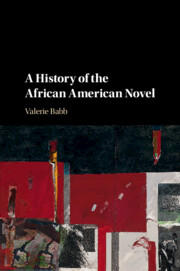Book contents
- Frontmatter
- Dedication
- Epigraph
- Contents
- List of Illustrations
- Acknowledgments
- PART I HISTORY
- Introduction: The Problem with the Title of this Volume
- 1 Out of Many One: The Beginnings of a Novelistic Tradition, 1850s– 1900s
- 2 Publish or Perish: African American Novels, 1900s– 1920s
- 3 Aesthetics of Race and Culture: African American Novels, 1920s– 1940s
- 4 Home of the Brave: African American Novels, 1940s– 1960s
- 5 Black Arts and Beyond: African American Novels, 1960s– 1970s
- 6 From Margin to Center: African American Novels, 1970s– 1990s
- 7 “Bohemian Cult Nats”: African American Novels, 1990s and Beyond
- PART II SIGNIFICANT GENRES OF THE AFRICAN AMERICAN NOVEL
- Coda
- Appendix
- Notes
- Works Cited
- Index
1 - Out of Many One: The Beginnings of a Novelistic Tradition, 1850s– 1900s
from PART I - HISTORY
Published online by Cambridge University Press: 28 July 2017
- Frontmatter
- Dedication
- Epigraph
- Contents
- List of Illustrations
- Acknowledgments
- PART I HISTORY
- Introduction: The Problem with the Title of this Volume
- 1 Out of Many One: The Beginnings of a Novelistic Tradition, 1850s– 1900s
- 2 Publish or Perish: African American Novels, 1900s– 1920s
- 3 Aesthetics of Race and Culture: African American Novels, 1920s– 1940s
- 4 Home of the Brave: African American Novels, 1940s– 1960s
- 5 Black Arts and Beyond: African American Novels, 1960s– 1970s
- 6 From Margin to Center: African American Novels, 1970s– 1990s
- 7 “Bohemian Cult Nats”: African American Novels, 1990s and Beyond
- PART II SIGNIFICANT GENRES OF THE AFRICAN AMERICAN NOVEL
- Coda
- Appendix
- Notes
- Works Cited
- Index
Summary
Writing and the Making of “African Americans”
When Michael Gomez observes that the “development of an initial capture account that points the finger exclusively at the European and excludes any mention of his African counterpart … marks an important stage in the emergence of the African American aggregate identity” (207), he might well be characterizing the basis of the written saga that would lay the groundwork for the African American novel. The repetition of a particular history – a taking of Africans by Europeans, the exactitude of servitude in America on plantations owned by whites, and the often self-engineered redemption from this servitude – would, in large part, cement many peoples of different African origins into a race. This narrative of shared enslavement became the foundational element of a consciousness of kind that would produce a body of literature engaging this history throughout its development. One of the earliest forms within this body was the slave narrative, and scholars have convincingly demonstrated its influence on traditions of black writing. Indeed, early African American novels mirror the arc of an enslaved black subject undergoing religious and liberatory redemption. But other influences might also have been at work in shaping their content. Though we may never know the many worldviews, rituals, and expressive forms that eventually found expression in the novel, as Frances Smith Foster suggests in her essay on the origins of African American print culture, it is time to ask what other elements informed African American literature.
Ayuba Suleiman Diallo (1701–1773) was an African Muslim who, in his memoir, recalled an odyssey from old world to new. Might the memory of his prominence in Senegambia before he was enslaved have influenced nineteenth-century imaginings of an African past? How well known were the ethnographically detailed letters of Philip Quaque, the first African ordained as a minister of the Church of England, describing what it was like to live as a free missionary within British slavery in eighteenth-century Cape Coast? To what extent did the exegesis in The Diary of Ben Ali written by Bilali Mohammed, a slave from Sapelo Island, Georgia, inform the growing interest in Islamic culture, evident in early black print culture?
- Type
- Chapter
- Information
- A History of the African American Novel , pp. 9 - 49Publisher: Cambridge University PressPrint publication year: 2017

